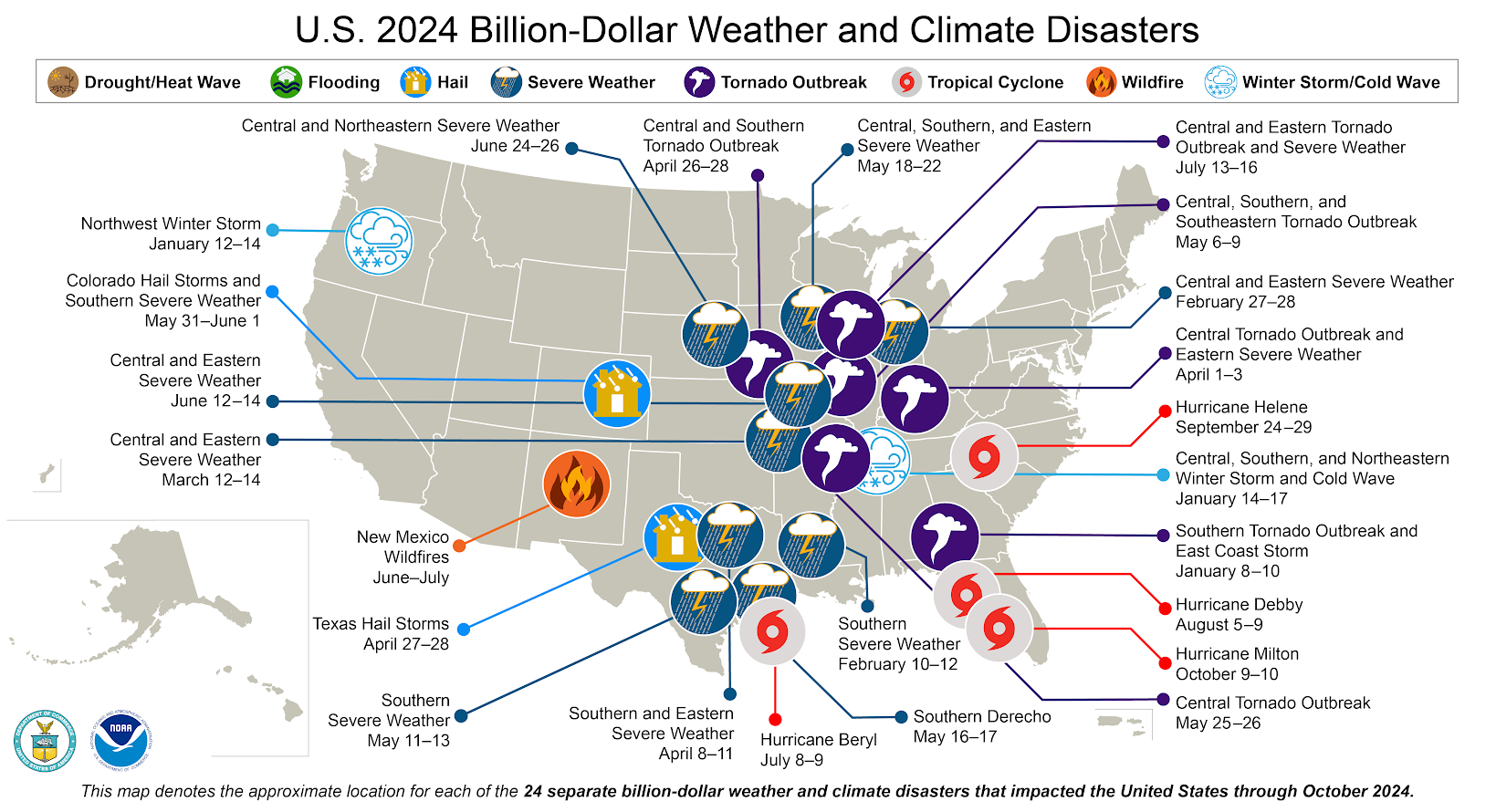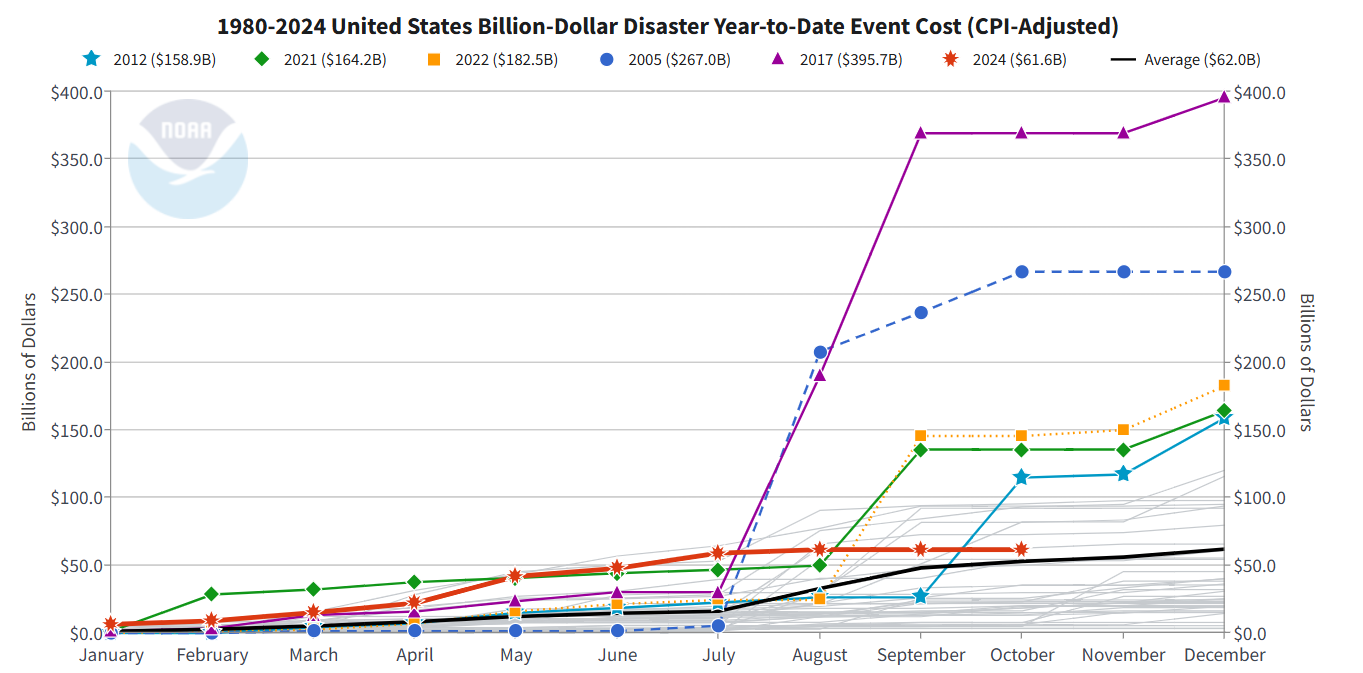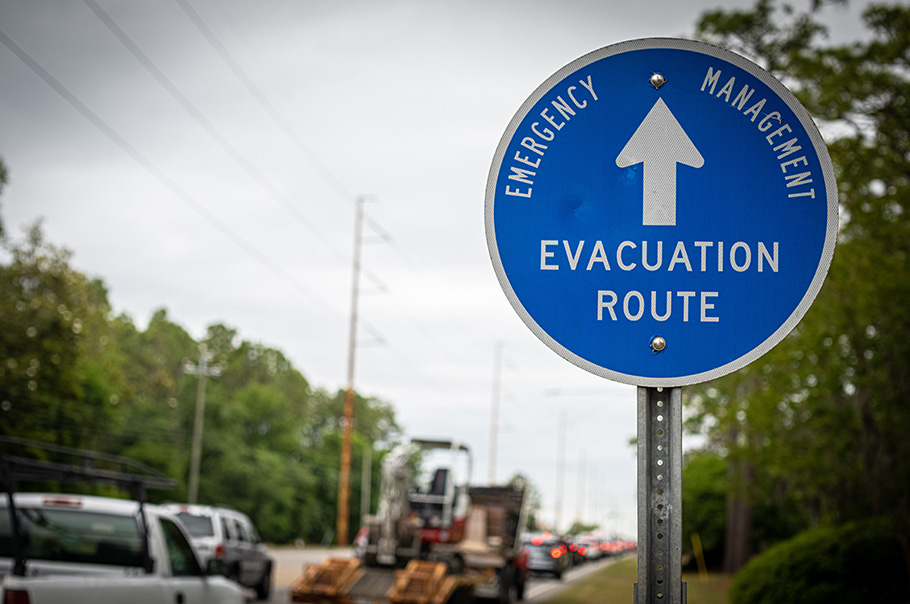Key Insights:
- Extreme weather events increasingly impact businesses, disrupting supply chains, markets, and financial stability.
- Data-driven insights and proactive planning are critical for managing weather-related risks.
- Pelmorex’s Weather Source OnPoint weather data solutions empower businesses with accurate weather data to anticipate and respond to these challenges effectively.
Extreme Weather is a Top Global Risk
The World Economic Forum’s Global Risk Report 2024 ranks extreme weather as the second most critical global risk in the next two years and the top risk over the coming decade. Events like heatwaves, floods, and cyclones are increasingly disruptive, damaging infrastructure, and posing serious threats to lives and businesses.
Extreme weather in 2024 is on track to become one of the costliest in history, underscoring the vulnerability of infrastructure and economies as climate impacts worsen. These events create long-term instability across industries, disrupting global supply chains, and forcing governments and businesses to confront new levels of risk.
Weather-related disruptions are no longer just an operational challenge; they are a strategic business risk that demands proactive and data-driven decision-making. By leveraging tools like Pelmorex’s Weather Source OnPoint weather data solutions, organizations gain a deeper understanding of weather patterns and their potential impacts, enabling them to not only respond effectively but to anticipate challenges ahead of time. As extreme weather events increase in frequency and intensity, the ability to make informed, weather-driven decisions is becoming essential for long-term business success.
Economic and Infrastructure Impacts
As of November 1, 2024, the United States has experienced 24 billion-dollar weather and climate disaster events, including 17 severe storms, 4 tropical cyclones, 1 wildfire and 2 winter storms, according to the National Centers for Environmental Information. These events led to 418 fatalities and had significant economic impacts on the impacted areas.
This year is nearly unprecedented, surpassed only by 2023, which also saw a historically high number of billion-dollar events.
Hurricane Milton:
Losses from Hurricane Milton in October could reach up to $34 billion, based on CoreLogic’s early estimates of flood and wind damage, with $4 to $6 billion of that total being uninsured flood losses. This figure only accounts for direct hurricane-related damage and excludes impacts from at least nine tornadoes that the storm spawned. Tragically, Hurricane Milton is also linked to at least 24 deaths across Florida.
Hurricane Beryl:
In July, Hurricane Beryl made landfall in Texas. Beryl generated more than 50 tornadoes and widespread power outages, impacting millions. The economic toll from Beryl alone exceeded $7.2 billion, exacerbating strains on emergency services and power infrastructure.
Severe Storms and Tornado Outbreaks:
A tornado outbreak in July affected many central and eastern states, resulting in record-breaking destruction in the Chicago area, and brought over 1,000 reports of high wind and hail damage. This event, along with other severe weather episodes, cost over $2.4 billion.
Wildfires and Heat Waves:
Wildfires, such as the South Fork Fire in New Mexico, destroyed over 1,000 structures and $1.7 billion in damages. At the same time relentless heat waves shattered temperature records across western and southern states, resulting in significant economic losses through reduced agricultural yields and increased energy costs.


These disasters impact more than just physical infrastructure. According to the WEF and Jefferson Public Radio they generate ripple effects across multiple industries.
Agriculture:
- Heat waves and droughts damage crops, leading to reduced yields and higher food prices.
- For example, California farmers have faced over $3 billion in insurance payouts since 2001 due to extreme weather.
- Additionally, these events also destabilize agricultural revenues, forcing farmers to contend with long-term economic losses and reduced food security.
Utilities and Energy:
- Extreme weather, including storms and high temperatures, puts additional strain on energy grids, leading to power outages and costly repairs.
- Utilities are investing in energy resilience strategies to adapt to more frequent disruptions, increasing operational costs.
- The rising need for infrastructure upgrades to handle the growing frequency of such weather events adds financial pressure across the sector.
Insurance:
- With the increase in extreme weather events, the insurance sector faces a surge in claims, especially in areas like homeowners and business insurance.
- As a result, insurance premiums are expected to rise significantly as insurers adjust their risk models.
- The recalculations of risk within the industry are reshaping the affordability and availability of coverage, which could impact businesses and homeowners nationwide.
These industries, as well as others, are grappling with the far-reaching economic impacts of extreme weather, driving profound shifts in industry operations and forcing businesses to rethink their strategies for the future.
Extreme Weather’s Impact on Business Uncertainty
Extreme weather events are escalating in both cost and frequency, creating significant risks for businesses as their impacts reverberate through supply chains, disrupt market dynamics, and threaten financial stability.
According to the Federal Reserve Bank of San Francisco (FRBSF), extreme weather events like hurricanes have inflicted massive financial damage and created uncertainty for businesses. They note that “extreme weather events can affect businesses in a variety of ways. In addition to damaging physical assets, such events can disrupt normal business activities, imposing costs like lost sales, evacuations, or shutting down and restarting of plant operations. Extreme weather events can also upset supply chains or slow demand for products.”
Navigating Extreme Weather Challenges
To navigate the challenges posed by these disruptions, companies can significantly benefit from integrating weather data into their business models. The Weather Source OnPoint Data Product Suite, part of Pelmorex’s suite of solutions, enables businesses to anticipate and manage the impacts of extreme weather through advanced, data-driven insights.
Offering a comprehensive range of historical, real-time, and forecasted weather data, Weather Source drives resilient, informed decision-making across sectors like retail, CPG, logistics, and manufacturing. As part of Pelmorex’s OnPoint Suite, Weather Source enables organizations to address weather-related challenges with precision, ensuring business continuity and strategic responsiveness to evolving weather risks.
Catch the replay of “Maximizing Sales with Extreme Weather Sales Impact Insights,” a webinar hosted by Weather Source and Seek, where we showcase how the new Extreme Weather Sales Impact App transforms weather data into actionable insights. This tool, available exclusively within Seek’s Insight Cloud, helps businesses turn disruptive weather events into sales opportunities by quantifying impacts on product demand, inventory, and operations.
Weather Source and Seek experts walk you through real-world examples, demonstrating how businesses can leverage these insights to optimize inventory management, prevent stockouts, and reduce risks, all while strengthening supply chains. Don’t miss out on this valuable session – watch the full playback now!



